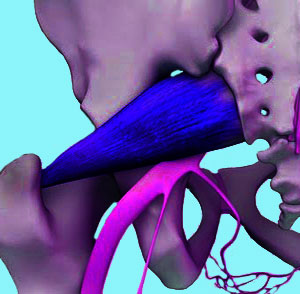
Piriformis surgery is a rare invasive form of treatment for unresponsive symptoms. Surgical intervention represents the extreme exception to the rule of conservative care for piriformis injury and piriformis syndrome. However, we have noticed a slowly growing trend towards more operative interventions year over year for the past decade. Some surgeons now even specialize in piriformis procedures and actively market their services to patients with severe pain problems.
The ability to perform safe surgery was a huge leap forward in modern medical advancement. There is no doubt that surgical interventions save many lives and allow effectual treatment of many conditions that can not be treated conservatively. However, surgery has become an overused therapy and is often utilized in cases where it does not demonstrate any advantages over noninvasive care.
This resource section details surgical techniques that can be used to treat piriformis syndrome. We will objectively explore the risks and benefits of these operations, as well as provide insider advice to patients who are considering surgical treatment.
Piriformis Surgery Indications
Surgery can be used to treat the piriformis muscle in different ways. There are few standardized procedures, since each example of piriformis pain is case-specific and often presents a completely different anatomical picture of causation.
There are piriformis procedures that seek to make the muscle more lax, since over-tensioning seems to be a problem. There are also opposing procedures that seek to tighten the piriformis when laxity is considered an issue. The former are far more common than the latter examples of surgical interventions.
Some procedures seek to detach the piriformis completely, while others seek to separate the sciatic nerve or pudendal nerves from entanglement with the piriformis, while maintaining the integrity of the muscle.
Remember that piriformis pain can be created in the muscle itself, in neighboring soft tissues or in the sciatic or pudendal nerves. These mechanics of action are all very different and therefore must be resolved using appropriate interventions.
Piriformis Syndrome Surgical Options
We have prepared a few topic-specific dialogs regarding some of the most common questions we receive concerning piriformis operations. As each new discussion is complete, it will be added to the following list:
Piriformis laser surgery is a common practice that can minimize collateral damage and improve healing, as well as reduce the rate of complications.
Failed piriformis surgery is a nightmare to endure, since now anatomical damage has been done that often can not be ignored. Once surgery fails, what can a patient do to find relief?
Piriformis procedures are broken down into a select group of surgical objectives. Each different types of procedure can address a specific type of piriformis pathology, such as tension, laxity or injury.
Piriformis Surgery Results
Piriformis procedures do not demonstrate results that are better than nonsurgical care. While many surgeries are successful in the short term, patients often report substitute symptoms in a nearby location within a short time-frame of under a year. While surgeons might consider this as a success, we categorize recurrence of pain as a complete failure.
Remember that nonsurgical care can often resolve most piriformis issues, barring those involving structural atypicalities that create nerve entrapment. Also remember that even anatomical irregularities are not inherently painful and many people demonstrate atypical sciatic nerve-through-muscle conditions without ever experiencing piriformis syndrome symptoms.
We tend to caution patients to avoid surgical care unless it becomes their last option for treating severe, chronic symptoms. There is simply not enough positive evidence of efficacy for us to get behind surgical intervention for most cases of piriformis pain, although some conditions might justify invasive care more than others. Always seek out multiple diagnostic opinions from surgeons and non-surgeons before considering any surgical approach to piriformis care.
It gives us great satisfaction that our proprietary pain relief program has helped so many patients to avoid piriformis surgery and still enjoy complete pain relief. Help is available 24 hours a day worldwide.
Piriformis Pain > Piriformis Surgery





